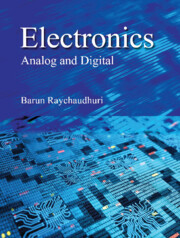Book contents
Summary
The semiconductor p–n junction is the most fundamental part of many electronic devices including diodes and transistors, and it is a basic element for understanding the working of other semiconductor devices. This chapter brings together the concepts on fabrication of a junction, barrier formation at the junction carrier and transport through it, forward and reverse biased conditions of a p–n junction and the corresponding energy band pictures and the wide variety of diodes that can be constructed using the p–n junction.
Fabrication of p–n Junction
Chapter 2 states that a piece of semiconductor, either n-type or p-type is a solid of variable electrical conductivity depending on the extent of doping. As soon as the combination of p- and n-type materials takes place, the electrical properties change radically. The junction acts a valve allowing current in a single direction. It is capable of converting an alternating input voltage or current to a pulsating direct voltage or current output, the phenomenon being referred to as the rectification.
Though it is called a ‘junction’, the p–n junction is not at all constructed by gluing or soldering two separate n-type and p-type pieces of semiconductors. In order to maintain the regularity of lattice structure, the same piece of intrinsic semiconductor crystal is doped for n- and p-type from two sides. Chapter 12 contains the detailed narration on the construction of p–n junction in connection with integrated circuit (IC) technology. The following are the common techniques of fabricating a p–n junction.
Grown Junction: This technique used to be adopted in the early days of semiconductor technology. In this process, the type of the dopant atom is abruptly changed during the crystal growth. For example, during crystal growth of silicon from melt, phosphorus is added for n-type doping and then boron atoms are added in larger concentration for p-type doping.
Alloyed Junction: This procedure is suitable for small scale production in laboratory. The doped semiconductor is alloyed with the material containing the opposite type of dopant. For example, n-type germanium is heated with indium to form a molten alloy. On cooling, the germanium grows out of the alloy because of redced solubility in solid state. At the interface of the alloy and the separated germanium, a region of germanium exists with high concentration of indium atoms and this germanium becomes p-type. Thus a p–n junction is formed.
- Type
- Chapter
- Information
- Electronics , pp. 61 - 100Publisher: Cambridge University PressPrint publication year: 2023



